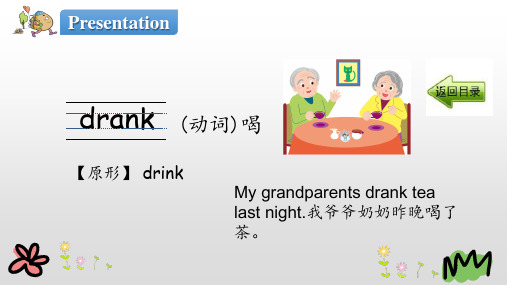人教版六年级英语PPT课件
合集下载
人教版英语六年级上册《Unit 5 What does he do》PPT精品课件

知识点1 询问他人工作地点的句型及回答
课本原句:—Where does he work? —He works at sea.
句型结构:—Where does+主语(第三人称单数)+work? —He/She works+表示地点的介词短语.
如果主语不是第三人称
单数,则问句中助动词
例句:Where does your brother work? He works on a farm.
Presentation
Head teacher
校长
Presentation
country
He often goes to other countries. I want to be a businessman.
知识点1
询问他人职业的句型及其回答
课本原句:—What does he do? —He's a businessman.
句子:
1.—Where does she work? —She works at a university.
Un学习目标
1.能听、说、读、写/where does your father/等句子, 并能在实际的情境中运用。 2.能、说、认读sea等单词。 3.能听懂、会说本课对话,并能在相应场景中运用。
Where does he work? He works __at__se_a____.
What does she do? She is a/an _s_ci_e_n_ti_s_t _. Where does she work? She works _a_t_a__un_i_ve_r_s_it_y__.
听力原文
Mike: Hi,Xiao Yu.Who's that tall man? xiaoYu: My uncle.
人教版六年级英语上册《My weekend plan》PPT课件

Summary
Words: film; look for; what about Sentences: what are you going to.···& have a good time
Exercise
汉译英,英译汉
nature park 看一场电影
自然公园 watch a film
明天
tomorrow
C. going
( B ) 2. I want to my book.
A. see
B. look for C. look at
( A ) 3. What are you going this morning?
A. to do
B. to
C. do
Exercise
Translations
Mike: What are you going to do tomorrow? 明天你要做什么? Sarah: I am going to have an art lesson. 我要上一节美术课 Mike: What are you going to do in your lesson? 美术课上做什么? Sarah: We’re going to draw some pictures in Renming Park. 我们要在人民公园画画。
Expressions
What are you going to do tomorrow?
明天你打算做什么? be going to是“一般将来时”的一种表现形式,表示将来某个时间将要发生的 动作或存在的状态,意思为“打算、将要” 。 常用例句: He is going to have a picnic next Sunday.
下个星期天他打算去野餐。
人教版六年级上册英语全册课件PPT

strong强 stronger较强 strongest最强
(1) 形容词的比较级和最高级的构成方法如下:
a. 单音节词和少数双音节词以加-er和-est的方式构成:
情况
加词尾法
例词
一般情况
直接加词尾
small, smaller, smallest
以e结尾的词
加-r,-st
large, larger, largest
difficult more difficult most difficult
Listen and read the song aloud. Then answer the questions.
What is Papa going to do? _______________________ _______________________ ________________________
school
pet hosoital
library
We can go by bike/bus/on foot.
cinema
常常用表示步骤的词
描述事情的顺序时,我们常常用表示步骤的词,如: first 首先, then 然后,next下一步等。其顺序如下: • first 首先,一定放在最前面 • next下面 • then 然后 • finally 最后, 一定在最后面 根据事情步骤的多少,选择来用。如:
教学 分析
教学 目标
教学 学法
教学 设计
说课 效果
项目
I’m going to … I’m going there by … I’m going there in July…
If 的用法
• if 表示“如果”,与将来时的句子连用。例 如:If it rains tomorrow, I will go to the park. (如果明天下雨,我将会去公园。)
人教版六年级英语上册《How do you feel?》PPT精品课件

presentation
Boys and girls, please give me some suggestions .
If a friend is ill. She should see a doctor .
take a deep breath count to ten 数到十
深呼吸
Please take a deep breath and count to ten ,then you will feel relaxed(放松的).
Let’s try It’s cold outside.Sam is talking with sarah.Listen and circle.
1.Where are they?
A.At home.
B. At school.
2. What will they do?
A. Eat at home. B. Watch films.
Let’s talk
Listen and try to finish the questions.
1.What does the cat do? The cat is a police officer. 2.Why is the cat angry with the mice? Because the mice are bad.They hurt people.
S1:I'm angry.What should I do? S2:You should take a deep breath and count to ten.
S1:I'm ______.What should I do? S2:You should_________.
Let’s try
人教版六年级英语上册Unit2 ppt课件

How do you come to school?
人教版六年级英语上册Unit2
I come by ship .
人教版六年级英语上册Unit2
How do you come to school?
人教版六年级英语上册Unit2
I come by bike .
人教版六年级英语上册Unit2
How does he get there? He gets there ….
人教版六年级英语上册Unit2
How do you come to school?
人教版六年级英语上册Unit2
I come by taxi.
人教版六年级英语上册Unit2
How do you come to school?
人教版六年级英语上册Unit2
I come by bus .
人教版六年级英语上册Unit2
人教版六年级英语上册Unit2
let's learn PartB
人教版六年级英语上册Unit2
Traffic lights
人教版六年级英语上册Unit2
slow
人教版六年级英语上册Unit2
down
人教版六年级英语上册Unit2 Nhomakorabeatop人教版六年级英语上册Unit2
helmet
人教版六年级英语上册Unit2
早到的
从 到达/到 人教版六年级英语上册Unit2
How does he get to the UK from China?
三单形式
人教版六年级英语上册Unit2
选择正确的答案。
( B )1.Usually I go to school on foot .
人教版小学英语六年级上册第三单元B部分Let's-talk-PPT课件

4
A:Where are you going ……?(时间) B:I’m going to the ……(地点) A:What are you going to buy ? B:I am going to buy ……(物品) A:When are you going ? B:I am going at ……(时刻) o’ clock.
5
A:Where are you going ……?(今天晚上)
B:I’m going to the ……(鞋店) A:What are you going to buy ? B:I am going to buy ……(一双鞋) A:When are you going ? B:I am going at ……(8点) o’ clock.
9
A:Where are you going ……?(星期日下午) B:I’m going to the ……(宠物店) A:What are you going to buy ? B:I am going to buy ……(一只猫) A:When are you going ? B:I am going at ……(4点) o’ clock.
8
A:Where are you going ……?(时间) B:I’m going to the ……(地点) A:What are you going to buy ? B:I am going to buy ……(物品) A:When are you going ? B:I am going at ……(时刻) o’ clock.
2
Where means 哪里,在哪里
What means 什么
When means
什么时候
A:Where are you going ……?(时间) B:I’m going to the ……(地点) A:What are you going to buy ? B:I am going to buy ……(物品) A:When are you going ? B:I am going at ……(时刻) o’ clock.
5
A:Where are you going ……?(今天晚上)
B:I’m going to the ……(鞋店) A:What are you going to buy ? B:I am going to buy ……(一双鞋) A:When are you going ? B:I am going at ……(8点) o’ clock.
9
A:Where are you going ……?(星期日下午) B:I’m going to the ……(宠物店) A:What are you going to buy ? B:I am going to buy ……(一只猫) A:When are you going ? B:I am going at ……(4点) o’ clock.
8
A:Where are you going ……?(时间) B:I’m going to the ……(地点) A:What are you going to buy ? B:I am going to buy ……(物品) A:When are you going ? B:I am going at ……(时刻) o’ clock.
2
Where means 哪里,在哪里
What means 什么
When means
什么时候
人教版六年级英语下册Unit2课件ppt

重点句型
1 How was your weekend? 你周末过得怎么样?
2
— What did you do?你做了什么? — I stayed at home and watched TV.
我待在家里看电视。
3 — Did you do anything else?你还做了其他什么事吗? — Yes, I did.是的,我做了。
I have a cold.
2. interesting, is, was, it(?) Was it interesting?
Presentation
Wu Yifan and his family stayed at the Holiday Hotel. It was not a happy time. Yifan will tell us what happened.
重点句型
Was it interesting?它有趣吗?
【句型结构】 Was/Were+主语+形容词?
【详解】这是一般过去时的句子,用来询问某人或某物在 过去是不是某种状态。
Were you busy yesterday?你昨天忙吗?
Test
连词成句。
1. cold, I, a, have(.)
was too small
Read and complete the sentences. I (cook)__co_o_k_e_d_dinner last Monday. I (play)__p_la_y_e_d_football last weekend. I (like) __li_k_e_d__the food yesterday. I (visit)_v_i_si_t_e_d_my grandparents last weekend. I (stop) _s_t_op_p_e_d_to look at the flower. I (study)_s_tu_d_i_ed__English last night.
人教版六年级英语上册第二单元课件PPT

教学分析
教学策略
教学过程
教学反思
02
01
02
03
04
教学分析
01
教学分析
30%
40%
80%
90%
添加标题
教学分析
教学分析
2013
2014
2018
2018
教学分析
添加文本: 点击此处添加你需要的内容,可以是一定篇幅的文本.
添加文本: 点击此处添加你需要的内容,可以是一定篇幅的文本.
B
B
C
B
C
一、开心三选一。
小练习
二、连词成句。 1. to park How can get the we ? _____________________________________ 2. by can bus You No.15 go the . _____________________________________ 3. the post do office go How to you ? _____________________________________ 4. train I go usually by . _____________________________________
slow down and stop at a yellow light
Don’t go at a yellow light. You must slow down and stop.
traffic rules(规则)
traffic lights
Remember the traffic rules.
Traffic rules 交通规则
green light
教学策略
教学过程
教学反思
02
01
02
03
04
教学分析
01
教学分析
30%
40%
80%
90%
添加标题
教学分析
教学分析
2013
2014
2018
2018
教学分析
添加文本: 点击此处添加你需要的内容,可以是一定篇幅的文本.
添加文本: 点击此处添加你需要的内容,可以是一定篇幅的文本.
B
B
C
B
C
一、开心三选一。
小练习
二、连词成句。 1. to park How can get the we ? _____________________________________ 2. by can bus You No.15 go the . _____________________________________ 3. the post do office go How to you ? _____________________________________ 4. train I go usually by . _____________________________________
slow down and stop at a yellow light
Don’t go at a yellow light. You must slow down and stop.
traffic rules(规则)
traffic lights
Remember the traffic rules.
Traffic rules 交通规则
green light
- 1、下载文档前请自行甄别文档内容的完整性,平台不提供额外的编辑、内容补充、找答案等附加服务。
- 2、"仅部分预览"的文档,不可在线预览部分如存在完整性等问题,可反馈申请退款(可完整预览的文档不适用该条件!)。
- 3、如文档侵犯您的权益,请联系客服反馈,我们会尽快为您处理(人工客服工作时间:9:00-18:30)。
教学反思
人教版小学英语六年级
学 生 根 据 实 际 情 况 说 句 子 , 比 如 “ I’m taller than ….I’m short than ….”等。
教学反思
要求学生写一段文章。内容包 括动物的体重、身高等方面。
人教版小学英语六年级
人教版小学英语六年级PPT课件
xxxxx
双击输入替换内容 双击输入替换内容 双击输入替换内容 双击输入 替换内容
人教版小学英语六年级PPT课件
xxxxx
双击输入替换内容 双击输入替换内容 双击输入替换内容 双击输入 替换内容
指导老师:xxxxx
目录 CONTENTS
教学分析
ADD THE TITEL
教学目标
ADD THE TITEL
教学过程
ADD THE TITEL
教学反思
ADD THE TITEL
01
教学分析
教学目标
人教版小学英语六年级
能够描写自己的年龄、身高、体重,并 能与别人进行比较。
03
教学过程
双击输入替换内容 双击输入替换内容 双击输入替换内容
教学过程
人教版小学英语六年级
Tall, tall, tall! Make yourself tall. Big, big, big! Make your eyes big. Long, long, long! Make your arms long. Short, short, short! Make yourself short. Small, small, small! Make your eyes small. Short, short, short! Make your arms short.
A
能听懂会说认读本单元关于形容词比较级的单词。
能听、说、读、写Let’s learn中黑体部分的内容和
B
Read and write中要求的内容。
C
能用目标语言完成本单元的任务型活动。
D
能学说Chant一首和Song一首。
教学目标
人教版小学英语六年级
Younger older Taller shorter longer
双击输入替换内容 双击输入替换内容 双击输入替换内容
教学分析
人教版小学英语六年级
本部分学习的是形容词的比较 级形式:younger, older, taller, shorter, longer等。
教学分析
人教版小学英语六年级
本单元学习的主题是比较人的身高体重。通过展 示孩子们在恐龙博物馆里参观的情境呈现本单元 要学习的核心词汇和句型。 这一单元的内容分为 主情景图、A、B和C 四个部分。
教学过程
人教版小学英语六年级
形容词比较级构成法: 1、大部分直接在后面加er 2、双写加er 3、以辅音字母加y结尾,把y改为i,再加er 4、以e有结尾的,直接加r
教学过程
人教版小学英语六年级
Let’s talk A: How old are you? B:I am ______ years old. What about you ? A: I am ______ years old. You are ______ years (months) older /younger than me. B: Yes, I am ____ years (months) older /younger than you.
教学目标
人教版小学英语六年级
能够听、说、认读句子: How tall are you? I’m 1.65metres. I’m taller. You’re older than me , too.
教学目标
人教版小学英语六年级
(1)能够运用上述单词描述人物的外貌特征; (2)能够理解形容词比较级的基本构词规律; (3)能够运用新学的内容完成 “Do a survey and report”任务。
Hale Waihona Puke 教学过程人教版小学英语六年级
Yao Ming is taller than Jay Zhou. Jay Zhou is shorter than Yao Ming. Yao Ming is_____taller than Jay Zhou.
04
教学反思
双击输入替换内容 双击输入替换内容 双击输入替换内容
教学反思
学生两人一组模仿Let’s read的内容。 正确使用句型“…is … than … ” 听录音,让学生找出新的单词和句 子
人教版小学英语六年级
教学反思
人教版小学英语六年级
教师请几位高矮胖瘦不同的学生到台前来,让 学生分辨Who is tall /strong/old/young/short?, 然后让学生回答。
指导老师:xxxxx
谢谢观看/欢迎下载
BY FAITH I MEAN A VISION OF GOOD ONE CHERISHES AND THE ENTHUSIASM THAT PUSHES ONE
TO SEEK ITS FULFILLMENT REGARDLESS OF OBSTACLES. BY FAITH I BY FAITH
教学分析
人教版小学英语六年级
教材通过孩子们对比身高、年龄等情景 呈现了单词比较级的词形和意义。
教学分析
培养学生学习英语的兴 趣,树立学生学习英语 的信心 。让学生养成积 极锻炼身体的习惯。
人教版小学英语六年级
02
教学目标
双击输入替换内容 双击输入替换内容 双击输入替换内容
教学目标
人教版小学英语六年级
